Multicriteria Analysis of Cement Mortar with Recycled Sand
Abstract
:1. Introduction
- The effect of recycled sand content on the properties of mortar such as consistency, flexural and compressive strengths, and durability.
- The evaluation of the environmental impact of using recycled sand in terms of carbon footprint, waste management index, and natural resource consumption.
- The assessment of the economic feasibility of using recycled sand in terms of production cost, market demand, and social benefits.
- The research aimed to provide a comprehensive and balanced analysis of the advantages and disadvantages of using recycled sand in mortar production and to propose optimal solutions for improving the sustainability of the construction industry.
2. Materials and Methods
3. Results
4. Discussion
5. Conclusions
- The use of recycled sand from concrete rubble in mortar production has a positive impact on the sustainability of the construction industry, as it reduces the carbon footprint, the waste management index, and the natural resource consumption of the material.
- The optimal replacement level of natural sand with recycled sand is between 40% and 60%, as it provides satisfactory flexural and compressive strengths, as well as minimizing the cost and the environmental impact of the mortar.
- The curing time is an important factor that affects the properties of mortar with recycled sand, as the differences in strength between natural and recycled sand decrease over time.
- The transport of materials is a significant aspect of the life cycle analysis of mortar with recycled sand, especially in the case of fine aggregates, which have limited availability in Europe.
Author Contributions
Funding
Institutional Review Board Statement
Informed Consent Statement
Data Availability Statement
Conflicts of Interest
References
- Feng, J.; Hou, H. Review of Research on Urban Social Space and Sustainable Development. Sustainability 2023, 15, 16130. [Google Scholar] [CrossRef]
- Pozzoli, M.; Nastari, R.; Pisano, S.; Venuti, M. How Circular Economy Disclosure Responds to Institutional Determinants Empirical Evidences in Non-Financial European Firms. Sustainability 2023, 15, 16069. [Google Scholar] [CrossRef]
- Korhonen, J.; Honkasalo, A.; Seppälä, J. Circular Economy: The Concept and its Limitations. Ecol. Econ. 2018, 143, 37–46. [Google Scholar] [CrossRef]
- Liao, L.; Ma, E.; Long, H.; Peng, X. Land Use Transition and Its Ecosystem Resilience Response in China during 1990–2020. Land 2023, 12, 141. [Google Scholar] [CrossRef]
- Zdeb, M.; Papciak, D. Disinfection of Rainwater for Economic Purposes. Sustainability 2023, 15, 16121. [Google Scholar] [CrossRef]
- Statista.com. Available online: https://www.statista.com/ (accessed on 26 November 2023).
- Abed, M.; Rashid, K.; Ul Rehman, M.; Ju, M. Performance keys on self-compacting concrete using recycled aggregate with fly ash by multi-criteria analysis. J. Clean. Prod. 2022, 378, 134398. [Google Scholar] [CrossRef]
- Bahrami, N.; Zohrabi, M.; Mahmoudy, S.A.; Akbari, M. Optimum recycled concrete aggregate and micro-silica content in self-compacting concrete: Rheological. mechanical and microstructural properties. J. Build. Eng. 2020, 31, 101361. [Google Scholar] [CrossRef]
- Behera, M.; Bhattacharyya, S.K.; Minocha, A.K.; Deoliya, R.; Maiti, S. Recycled aggregate from C&D waste & its use in concrete—A breakthrough towards sustainability in construction sector: A review. Constr. Build. Mater. 2014, 68, 501–516. [Google Scholar] [CrossRef]
- Ul Rehman, M.; Rashid, K.; Zafar, I.; Alqahtani, F.K.; Iqbal Khan, M. Formulation and characterization of geopolymer and conventional lightweight green concrete by incorporating synthetic lightweight aggregate. J. Build. Eng. 2020, 31, 101363. [Google Scholar] [CrossRef]
- Wang, B.; Yan, L.; Fu, Q.; Kasal, B. A Comprehensive Review on Recycled Aggregate and Recycled Aggregate Concrete. Resour. Conserv. Recycl. 2021, 171, 105565. [Google Scholar] [CrossRef]
- Verian, K.P.; Ashraf, W.; Cao, Y. Properties of recycled concrete aggregate and their influence in new concrete production. Resour. Conserv. Recycl. 2018, 133, 30–49. [Google Scholar] [CrossRef]
- Hossain, M.U.; Poon, C.S.; Lo, I.; Cheng, J. Comparative environmental evaluation of aggregate production from recycled waste materials and virgin sources by LCA. Resour. Conserv. Recycl. 2016, 109, 67–77. [Google Scholar] [CrossRef]
- Da, S.; Le Billon, P. Sand mining: Stopping the grind of unregulated supply chains. Extr. Ind. Soc. 2022, 10, 101070. [Google Scholar] [CrossRef]
- Kępniak, M.; Woyciechowski, P. Influence of sand substitution with waste lime powder on the concrete carbonation. Arch. Civ. Eng. 2021, 67, 383–392. [Google Scholar] [CrossRef]
- Kępniak, M.; Woyciechowski, P.; Franus, W. Transition Zone Enhancement with Waste Limestone Powder as a Reason for Concrete Compressive Strength Increase. Materials 2021, 14, 7254. [Google Scholar] [CrossRef] [PubMed]
- Chyliński, F.; Bobrowicz, J.; Łukowski, P. Undissolved Ilmenite Mud from TiO2 Production—Waste or a Valuable Addition to Portland Cement Composites? Materials 2020, 13, 3555. [Google Scholar] [CrossRef]
- Reshma, T.V.; Patnaikuni, C.K.; Tanu, H.M.; Bharath, A. Evaluation of strength, durability, and microstructure characteristics of slag-sand-induced concrete. Clean. Mater. 2023, 10, 100212. [Google Scholar] [CrossRef]
- Jiang, X.; Zhang, Y.; Zhang, Y.; Ma, J.; Xiao, R.; Guo, F.; Bai, Y.; Huang, B. Influence of size effect on the properties of slag and waste glass-based geopolymer paste. J. Clean. Prod. 2023, 383, 135428. [Google Scholar] [CrossRef]
- Dinh, H.L.; Liu, J.; Ong, D.; Doh, J.H. A sustainable solution to excessive river sand mining by utilizing by-products in concrete manufacturing: A state-of-the-art review. Clean. Mater. 2022, 6, 100140. [Google Scholar] [CrossRef]
- Zhao, D.; Hong, L.; Yu, Z.; Guo, B.; Gao, P.; Chen, L.; Zhan, B.; Yu, Q. Quick extraction of recycled sand morphology parameters based on deep learning and their effect on mortar property. Case Stud. Constr. Mater. 2023, 19, e02644. [Google Scholar] [CrossRef]
- Jiang, X.; Xiao, R.; Bai, Y.; Huang, B.; Ma, Y. Influence of waste glass powder as a supplementary cementitious material (SCM) on physical and mechanical properties of cement paste under high temperatures. J. Clean. Prod. 2022, 340, 130778. [Google Scholar] [CrossRef]
- Li, L.; Zhan, B.J.; Lu, J.; Poon, C.S. Systematic evaluation of the effect of replacing river sand by different particle size ranges of fine recycled concrete aggregates (FRCA) in cement mortars. Constr. Build. Mater. 2019, 209, 147–155. [Google Scholar] [CrossRef]
- Singh, R.; Nayak, D.; Pandey, A.; Kumar, R.; Kumar, V. Effects of recycled fine aggregates on properties of concrete containing natural or recycled coarse aggregates: A comparative study. J. Build. Eng. 2022, 45, 103442. [Google Scholar] [CrossRef]
- Estephane, P.; Garboczi, E.J.; Bullard, J.W.; Wallevik, O.H. Three-dimensional shape characterization of fine sands and the influence of particle shape on the packing and workability of mortars. Cem. Concr. Compos. 2019, 97, 125–142. [Google Scholar] [CrossRef]
- Feng, Y.; Zhang, B.; Xie, J.; Xue, Z.; Huang, K.; Tan, J. Effects of recycled sand and nanomaterials on ultra-high performance concrete: Workability. compressive strength and microstructure. Constr. Build. Mater. 2023, 378, 131180. [Google Scholar] [CrossRef]
- Regulation (EU) 2020/852 of the European Parliament and of the Council of 18 June 2020 on the Establishment of a Framework to Facilitate Sustainable Investment. and Amending Regulation (EU) 2019/2088 (Text with EEA Relevance) PE/20/2020/INIT. Available online: http://data.europa.eu/eli/reg/2020/852/oj (accessed on 1 January 2024).
- Czarnecki, L.; Sokołowska, J.J. Material model and revealing the truth. Bull. Pol. Acad. Sci. Tech. 2015, 63, 7–14. [Google Scholar] [CrossRef]
- Garbacz, A.; Sokołowska, J.J. Concrete-like polymer composites with fly ashes—Comparative study. Constr. Build. Mater. 2013, 38, 689–699. [Google Scholar] [CrossRef]
- EN 933-11; Tests for Geometrical Properties of Aggregates—Part 11: Classification Test for the Constituents of Coarse Recycled Aggregate. European Committee for Standardization (CEN): Brussels, Belgium, 2005.
- EN 1015-3:1999; Methods of Test for Mortar for Masonry—Part 3: Determination of Consistence of Fresh Mortar (by Flow Table). European Committee for Standardization (CEN): Brussels, Belgium, 1999.
- EN 196-1; Methods of Testing Cement—Part 1: Determination of Strength. European Committee for Standardization (CEN): Brussels, Belgium, 2016.
- EN 15804; Environmental Product Declaration. European Committee for Standardization (CEN): Brussels, Belgium, 2012.
- Environmental Declaration Type III—EPD Cements CEM I. CEM II. CEM III. CEM IV. CEM V Manufactured in Poland. Available online: https://www.polskicement.pl/ (accessed on 26 November 2023).
- Ehsani, M.; Ahmadi, A.; Fadai, D. Modeling of vehicle fuel consumption and carbon dioxide emission in road transport. Renew. Sustain. Energy Rev. 2016, 53, 1638–1648. [Google Scholar] [CrossRef]
- Jakhrani, A.Q.; Rigit, A.R.H.; Othman, A.-K.; Samo, S.R.; Kamboh, S.A. Estimation of carbon footprints from diesel generator emissions. In Proceedings of the 2012 International Conference on Green and Ubiquitous Technology, Bandung, Indonesia, 7–8 July 2012; pp. 78–81. [Google Scholar] [CrossRef]
- Botto, S. Tap Water vs. Bottled Water in a Footprint Integrated Approach. Nat. Preced. 2009, 1, 1–18. [Google Scholar] [CrossRef]
- Zhu, X.; Zhang, Y.; Liu, Z.; Qiao, H.; Ye, F.; Lei, Z. Research on carbon emission reduction of manufactured sand concrete based on compressive strength. Constr. Build. Mater. 2023, 403, 133101. [Google Scholar] [CrossRef]
- Harrington, E.C. The desirability function. Ind. Qual. Control 1965, 10, 494–498. [Google Scholar]
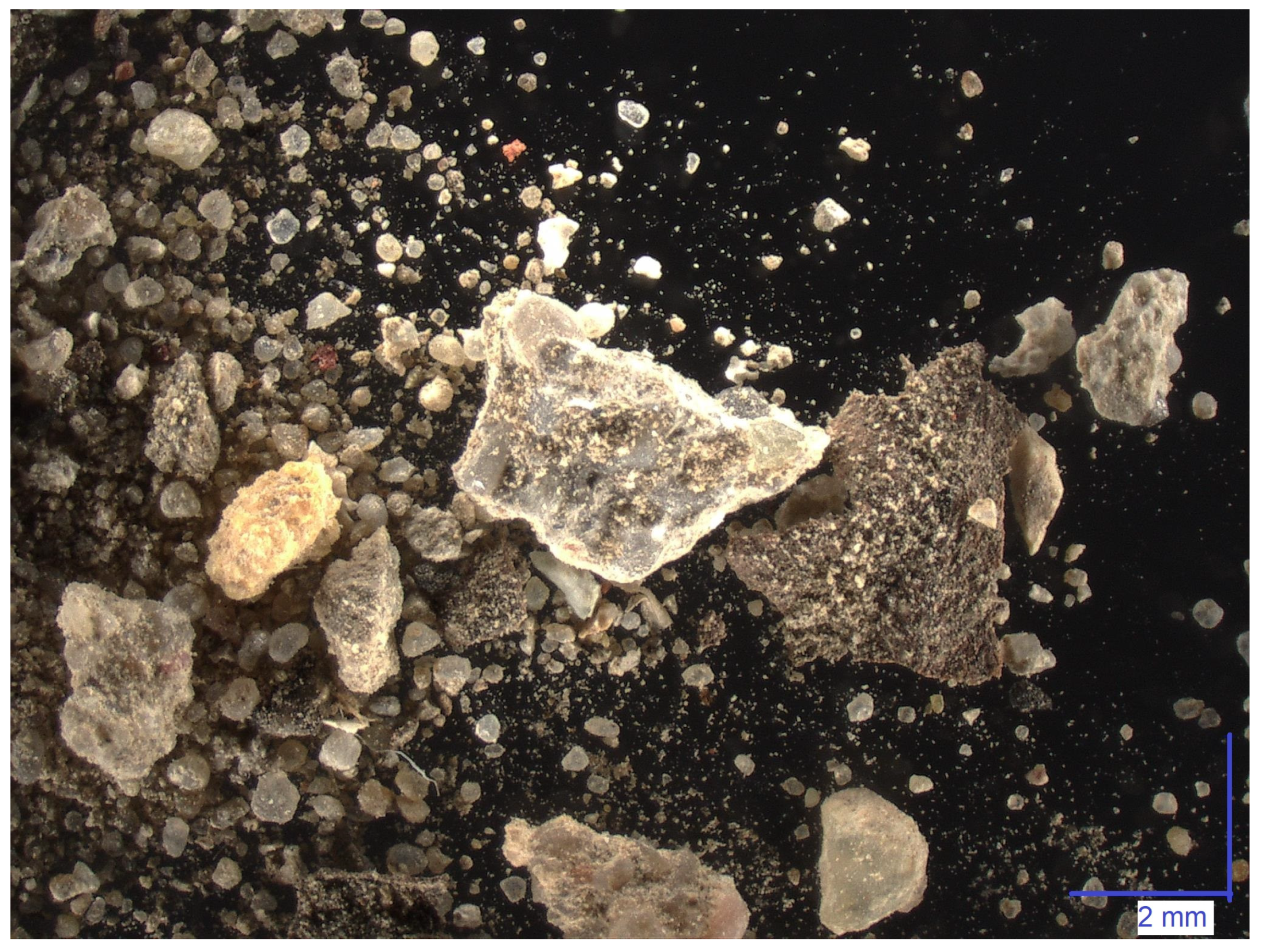
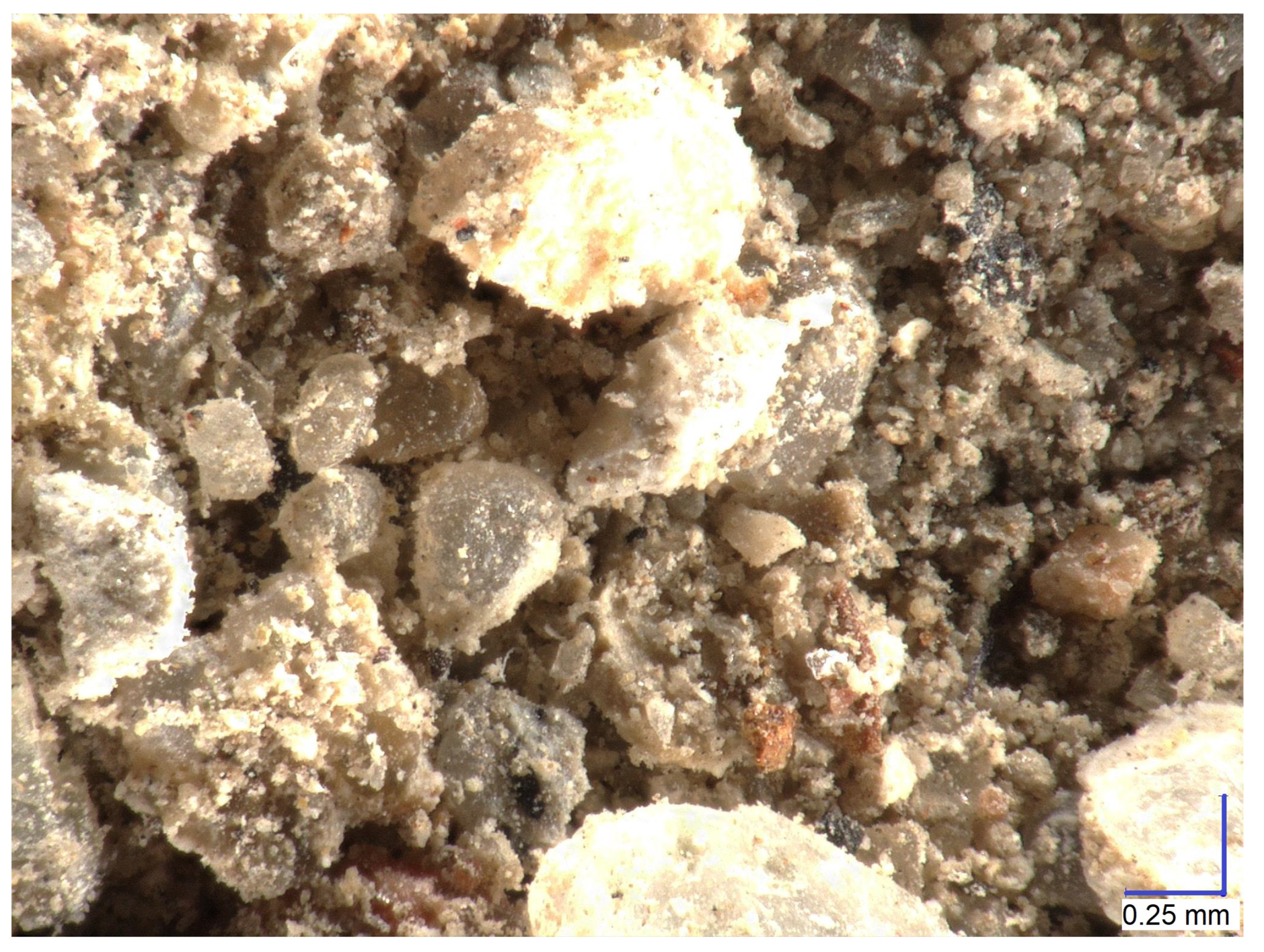

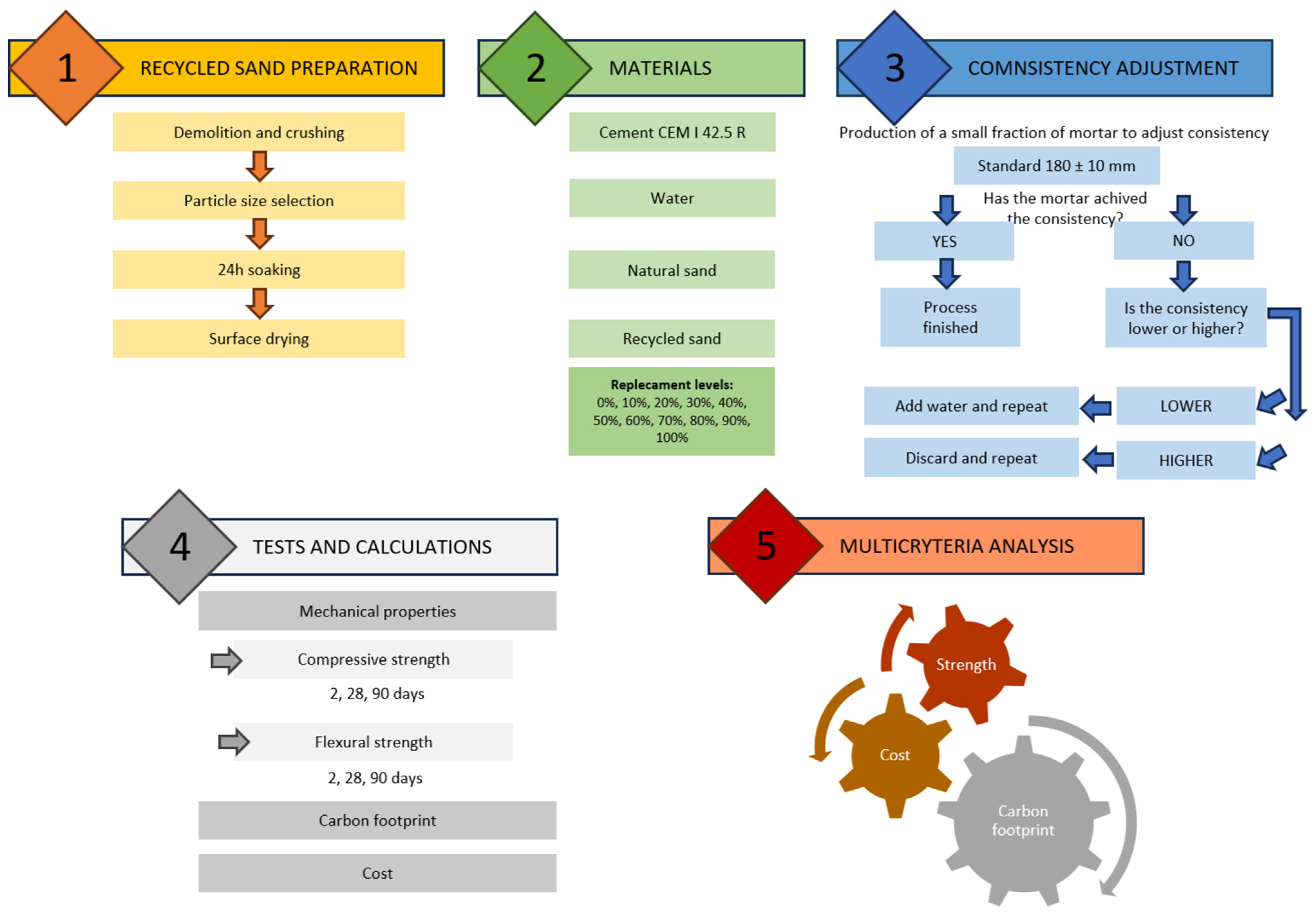
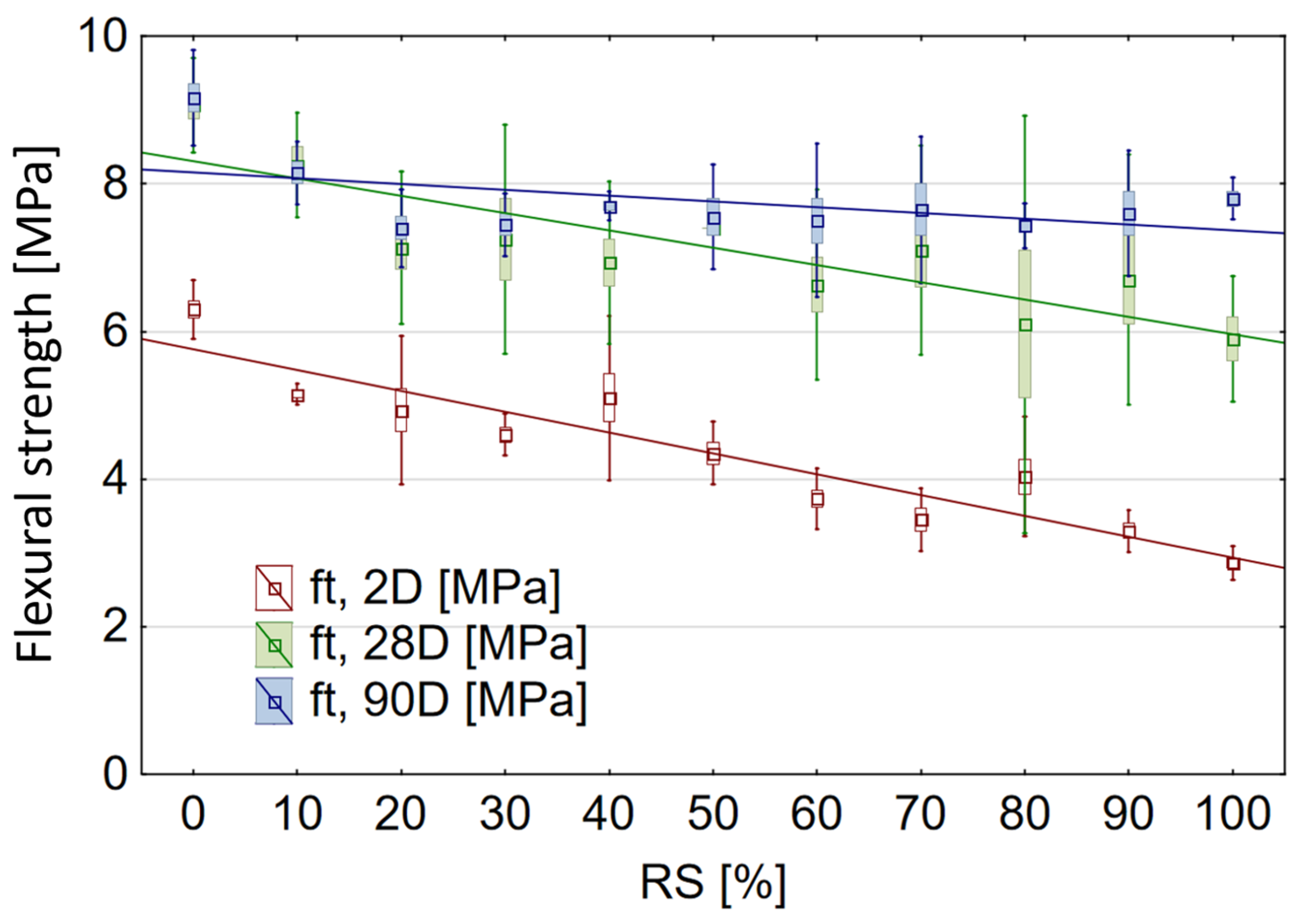

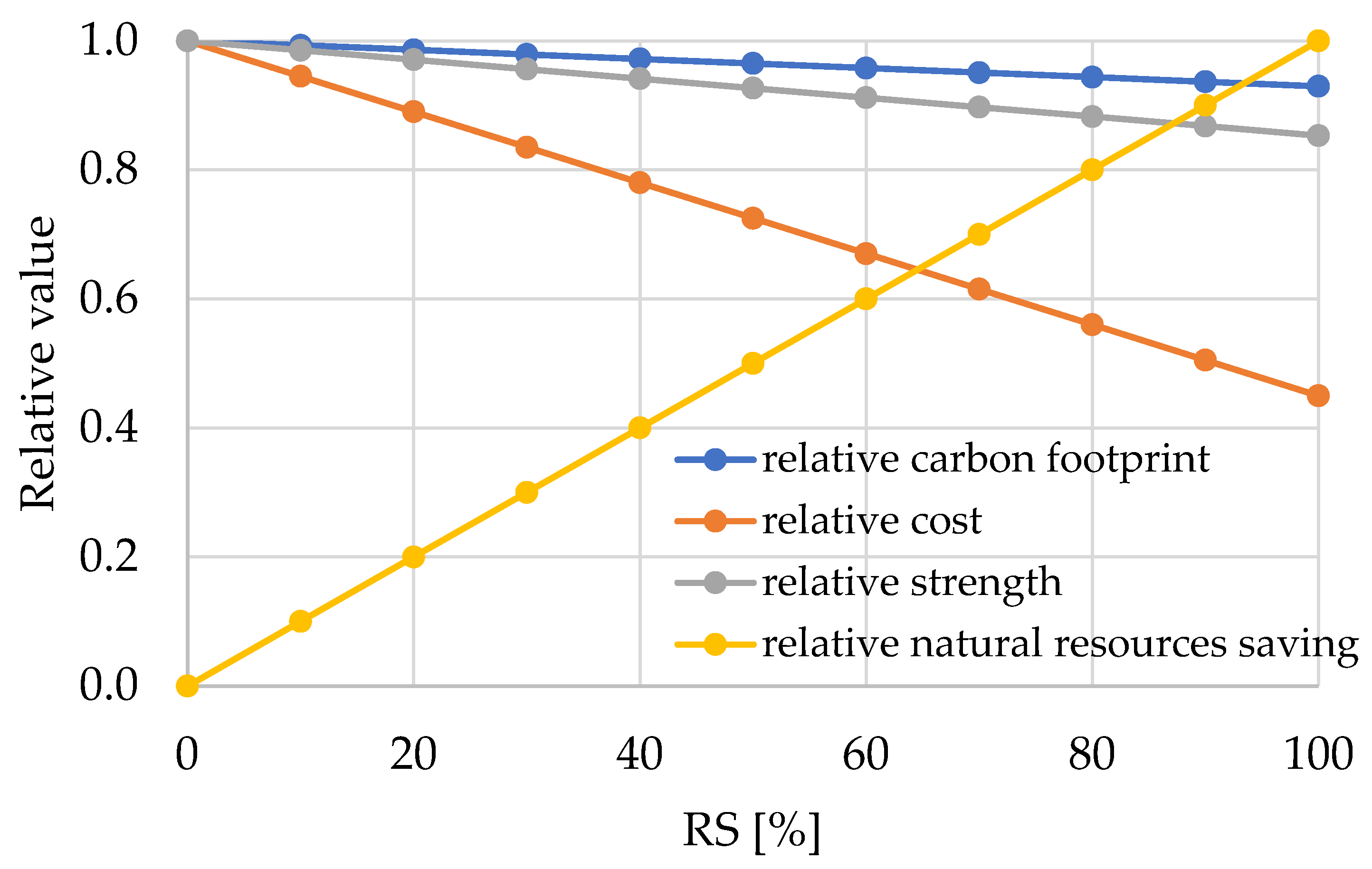

| Composition 1 | Cement, kg | Water, kg | Natural Sand, kg | Recycled Sand, kg |
|---|---|---|---|---|
| RS00 | 600 | 300 | 1803 | 0 |
| RS10 | 600 | 283 | 1622 | 199 |
| RS20 | 600 | 264 | 1442 | 397 |
| RS30 | 600 | 247 | 1262 | 596 |
| RS40 | 600 | 228 | 1082 | 793 |
| RS50 | 600 | 211 | 901 | 992 |
| RS60 | 600 | 192 | 721 | 1190 |
| RS70 | 600 | 174 | 541 | 1389 |
| RS80 | 600 | 156 | 361 | 1586 |
| RS90 | 600 | 139 | 180 | 1785 |
| RS100 | 600 | 120 | 0 | 1983 |
| Component | Carbon Footprint Calculation (kg CO2 /t) | Source of Information | |
|---|---|---|---|
| Cement | production | 812.00 | [34] |
| transport | assumed distance: 200 km fuel consumption approx. 30 L/100 km with a full load of 27 tons of cement, 20 L/100 km empty consumption of one liter diesel emits around 2.7 kg of CO2 10.00 | [35,36] | |
| Water | treatment and procurement | 0.91 | [37] |
| Natural sand | mining | 6.60 | [38] |
| transport | assumed distance: 400 km fuel consumption approx. 28 L/100 km with a full load of 20 tons of sand, 20 L/100 km empty consumption of one liter diesel emits around 2.7 kg of CO2 25.92 | [36,39] | |
| Recycled sand | crushing | 8.48 | [38] |
| transport | assumed distance: 20 km fuel consumption approx. 28 L/100 km with a full load of 20 tons of sand, 20 L/100 km empty consumption of one liter diesel emits around 2.7 kg of CO2 1.30 | [35,36] |
| 2 Days | 28 Days | 90 Days | ||||
|---|---|---|---|---|---|---|
| Composition | ft (MPa) | fc (MPa) | ft (MPa) | fc (MPa) | ft (MPa) | fc (MPa) |
| RS00 | 6.3 ± 0.2 | 24.6 ± 0.8 | 9.1 ± 0.3 | 52.1 ± 1.0 | 9.2 ± 0.3 | 55.0 ± 1.7 |
| RS10 | 5.2 ± 0.1 | 20.5 ± 1.3 | 8.3 ± 0.3 | 52.5 ± 2.1 | 8.2 ± 0.2 | 53.8 ± 2.3 |
| RS20 | 4.9 ± 0.4 | 22.4 ± 0.6 | 7.1 ± 0.4 | 46.4 ± 2.2 | 7.4 ± 0.2 | 51.0 ± 1.6 |
| RS30 | 4.6 ± 0.1 | 19.0 ± 0.6 | 7.3 ± 0.6 | 49.1 ± 0.8 | 7.5 ± 0.2 | 49.1 ± 2.3 |
| RS40 | 5.1 ± 0.5 | 19.6 ± 0.3 | 6.9 ± 0.4 | 44.8 ± 1.3 | 7.7 ± 1.1 | 51.3 ± 1.4 |
| RS50 | 4.4 ± 0.2 | 16.9 ± 0.3 | 7.4 ± 0.1 | 45.3 ± 0.2 | 7.6 ± 0.3 | 49.6 ± 1.9 |
| RS60 | 3.7 ± 0.2 | 15.4 ± 0.9 | 6.6 ± 0.5 | 44.1 ± 2.1 | 7.5 ± 0.4 | 50.5 ± 1.1 |
| RS70 | 3.5 ± 0.2 | 15.0 ± 0.7 | 7.1 ± 0.5 | 44.5 ± 1.0 | 7.7 ± 0.4 | 50.3 ± 1.3 |
| RS80 | 4.0 ± 0.3 | 15.4 ± 0.6 | 6.1 ± 1.0 | 39.7 ± 1.4 | 7.4 ± 0.1 | 47.4 ± 2.2 |
| RS90 | 3.3 ± 0.1 | 15.0 ± 0.3 | 6.7 ± 0.6 | 42.7 ± 0.9 | 7.6 ± 0.3 | 45.9 ± 2.1 |
| RS100 | 2.9 ± 0.1 | 12.0 ± 0.1 | 5.9 ± 0.3 | 39.4 ± 0.9 | 7.8 ± 0.1 | 45.9 ± 1.0 |
| Composition | fc,90 Days (MPa) | Carbon Footprint (kg/m3) | Cost (EUR) | Natural Resources Saving (kg) |
|---|---|---|---|---|
| RS00 | 55.0 | 552 | 205.67 | 0 |
| RS10 | 53.8 | 548 | 194.36 | 181 |
| RS20 | 51.0 | 544 | 183.04 | 361 |
| RS30 | 49.1 | 540 | 171.73 | 541 |
| RS40 | 51.3 | 537 | 160.42 | 721 |
| RS50 | 49.6 | 533 | 149.11 | 902 |
| RS60 | 50.5 | 529 | 137.80 | 1082 |
| RS70 | 50.3 | 525 | 126.49 | 1262 |
| RS80 | 47.4 | 521 | 115.17 | 1442 |
| RS90 | 46.9 | 517 | 103.87 | 1623 |
| RS100 | 46.1 | 513 | 92.55 | 1803 |
| Composition | fc,90 Days | Carbon Footprint | Cost | Natural Resources Saving |
|---|---|---|---|---|
| RS00 | 1.000 | 1.000 | 1.000 | 0.000 |
| RS10 | 0.985 | 0.993 | 0.945 | 0.100 |
| RS20 | 0.971 | 0.986 | 0.890 | 0.200 |
| RS30 | 0.956 | 0.979 | 0.835 | 0.300 |
| RS40 | 0.941 | 0.972 | 0.780 | 0.400 |
| RS50 | 0.927 | 0.965 | 0.725 | 0.500 |
| RS60 | 0.912 | 0.958 | 0.670 | 0.600 |
| RS70 | 0.897 | 0.951 | 0.615 | 0.700 |
| RS80 | 0.882 | 0.944 | 0.560 | 0.800 |
| RS90 | 0.868 | 0.937 | 0.505 | 0.900 |
| RS100 | 0.853 | 0.929 | 0.450 | 1.000 |
| fc,90 Days | Carbon Footprint | Cost | Natural Resources Saving | |
|---|---|---|---|---|
| weight of the feature | 0.5 | 0.2 | 0.2 | 0.1 |
| better value | 50 MPa | 525 kg/m3 | EUR 205 | 1803 kg |
| worse value | 47 MPa | 550 kg/m3 | EUR 150 | 900 kg |
Disclaimer/Publisher’s Note: The statements, opinions and data contained in all publications are solely those of the individual author(s) and contributor(s) and not of MDPI and/or the editor(s). MDPI and/or the editor(s) disclaim responsibility for any injury to people or property resulting from any ideas, methods, instructions or products referred to in the content. |
© 2024 by the authors. Licensee MDPI, Basel, Switzerland. This article is an open access article distributed under the terms and conditions of the Creative Commons Attribution (CC BY) license (https://creativecommons.org/licenses/by/4.0/).
Share and Cite
Kępniak, M.; Łukowski, P. Multicriteria Analysis of Cement Mortar with Recycled Sand. Sustainability 2024, 16, 1773. https://doi.org/10.3390/su16051773
Kępniak M, Łukowski P. Multicriteria Analysis of Cement Mortar with Recycled Sand. Sustainability. 2024; 16(5):1773. https://doi.org/10.3390/su16051773
Chicago/Turabian StyleKępniak, Maja, and Paweł Łukowski. 2024. "Multicriteria Analysis of Cement Mortar with Recycled Sand" Sustainability 16, no. 5: 1773. https://doi.org/10.3390/su16051773
APA StyleKępniak, M., & Łukowski, P. (2024). Multicriteria Analysis of Cement Mortar with Recycled Sand. Sustainability, 16(5), 1773. https://doi.org/10.3390/su16051773





